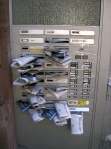 Trading goods and services without the use of money has been around forever. Early civilizations relied on this kind of exchange as most of them had no form of cash. And when the Americas were colonized, the Europeans used bartering with the indigenous people as the locals had no desire for printed money. They couldn’t eat it and they had nowhere to spend it. To them it was just paper. The practice of bartering is still in use today, but to a much lesser extent, simply because it is very hard to give someone change when they want to pay for a chicken and the smallest thing they have to pay for it is a cow. But aside from the implications of keeping spare chickens as change, I think it is a practice which is way too often overlooked by companies short on cash flow but flush with stock (be it intellectual or warehouse stock).
Trading goods and services without the use of money has been around forever. Early civilizations relied on this kind of exchange as most of them had no form of cash. And when the Americas were colonized, the Europeans used bartering with the indigenous people as the locals had no desire for printed money. They couldn’t eat it and they had nowhere to spend it. To them it was just paper. The practice of bartering is still in use today, but to a much lesser extent, simply because it is very hard to give someone change when they want to pay for a chicken and the smallest thing they have to pay for it is a cow. But aside from the implications of keeping spare chickens as change, I think it is a practice which is way too often overlooked by companies short on cash flow but flush with stock (be it intellectual or warehouse stock).
 Even as kids we knew the value of bartering. Do you remember back in school when you would swap your juice for chips, or cookies for Twinkies? Even as children we had a very real sense of the comparable value of things. To the kid who gets cookies in his lunch every day, that elusive cream-filled gooey cake treat is worth maybe a week’s worth of cookies, but he also realizes that his friend might feel completely different. To the Twinkie kid, cookies might be a really nice change. After all, how many Twinkies can one actually stand? The value of any given product in a barter system is based on how much the other person values what is on offer. A heater in Alaska is worth way more than an air conditioner, but the same can’t be said in Texas. It’s all relative.
Even as kids we knew the value of bartering. Do you remember back in school when you would swap your juice for chips, or cookies for Twinkies? Even as children we had a very real sense of the comparable value of things. To the kid who gets cookies in his lunch every day, that elusive cream-filled gooey cake treat is worth maybe a week’s worth of cookies, but he also realizes that his friend might feel completely different. To the Twinkie kid, cookies might be a really nice change. After all, how many Twinkies can one actually stand? The value of any given product in a barter system is based on how much the other person values what is on offer. A heater in Alaska is worth way more than an air conditioner, but the same can’t be said in Texas. It’s all relative.
 Some would argue that bartering won’t work for everything. And that is probably true. That is why money was invented in the first place. With money the problems involved with bartering either disappear or severely diminish. You no longer have to find people who want what you have and are willing to barter their stuff for whatever you are offering. Carrying coins is also a hell of a lot easier than carrying cows.
Some would argue that bartering won’t work for everything. And that is probably true. That is why money was invented in the first place. With money the problems involved with bartering either disappear or severely diminish. You no longer have to find people who want what you have and are willing to barter their stuff for whatever you are offering. Carrying coins is also a hell of a lot easier than carrying cows.
But the marketing services industry has been using bartering for years. For instance, businesses often trade goods or services for advertising space or marketing. Newspapers offer ad space, shops offer the side of their building for billboard space, film producers offer product placements – the opportunities are virtually limitless. Sponsorships and promotions work the same way. If Coke buys the uniforms for a kids sports team, the teams can agree to put the Coca-Cola logo on each jersey and hang banner ads in their local sports park.
And while we designed the ad above to be a cheeky spot for the Marketing Thought social media page (see here), we will actually work for wine. As long as it is a decent quality Red in lots of at least 4 cases. The concept is not entirely new to Marketing Thought, we have arranged contra bartering deals for restaurant vouchers for w2eat.co.nz, traded ad space for a Peugeot scooter, and we know a flight partner that contras everything they do in marketing for flights (but we have to keep who they are a secret). Of course money is better for paying the bills, but sometimes the barter system suits what you have to offer.
Click here to receive Marketing Thought’s eBook
eMarketing gains, myths, misnomers and “To DIY or not to DIY”




